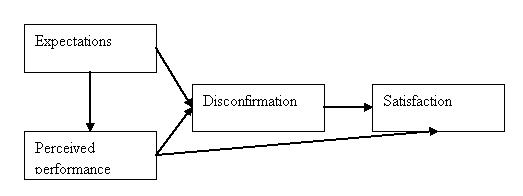Difference between revisions of "Expectation confirmation theory"
m (Text replace - "thumb|right|134px|[http://http://www.prin.edu// Site sponsor] thumb|right|134px|[http://www.yorku.ca/ Site sponsor]" to "") |
m (Text replace - "thumb|right|134px|This site is associated with [http://www.aisworld.org/ AISWorld]" to "{{Sponsor Thumbs}}") |
||
| Line 1: | Line 1: | ||
| − | + | {{Sponsor Thumbs}} | |
Revision as of 06:07, 16 November 2011

Expectation confirmation theory
Acronym
ECT
Alternate name(s)
Expectation disconfirmation theory (EDT)
Main dependent construct(s)/factor(s)
Satisfaction
Main independent construct(s)/factor(s)
Expectations, Perceived performance, Disconfirmation
Concise description of theory
Expectations-confirmation theory posits that expectations, coupled with perceived performance, lead to post-purchase satisfaction. This effect is mediated through positive or negative disconfirmation between expectations and performance. If a product outperforms expectations (positive disconfirmation) post-purchase satisfaction will result. If a product falls short of expectations (negative disconfirmation) the consumer is likely to be dissatisfied (Oliver, 1980; Spreng et al. 1996).
The four main constructs in the model are: expectations, performance, disconfirmation, and satisfaction. Expectations reflect anticipated behavior (Churchill and Suprenant, 1982). They are predictive, indicating expected product attributes at some point in the future (Spreng et al. 1996). Expectations serve as the comparison standard in ECT – what consumers use to evaluate performance and form a disconfirmation judgment (Halstead, 1999). Disconfirmation is hypothesized to affect satisfaction, with positive disconfirmation leading to satisfaction and negative disconfirmation leading to dissatisfaction.
A major debate within the marketing literature concerns the nature of the effect of disconfirmation on satisfaction. The root of the problem lies in the definition of predictive expectations as the comparison standard for perceived performance. In such case, the confirmation of negative expectations is not likely to lead to satisfaction (Santos and Boote 2003). To overcome this problem, researchers have proposed other comparison standards such as desires, ideals, equity, or past product and brand experience (see reviews by Halstead, 1999; Yi 1990 and analysis by Tse and Wilton, 1988. Also see Spreng et al. 1996; Woodruff et al., 1983).
Diagram/schematic of theory
Originating author(s)
Oliver (1977, 1980)
Seminal articles
Oliver R. L, 1977, "Effect of Expectation and Disconfirmation on Postexposure Product Evaluations - an Alternative Interpretation," Journal of Applied Psychology, 62(4), p. 480.
Oliver R. L, 1980, "A Cognitive Model of the Antecedents and Consequences of Satisfaction Decisions," JMR, Journal of Marketing Research, 17(4), p. 460.
Spreng R. A, S.B. MacKenzie and R.W. Olshavsky, 1996, "A reexamination of the determinants of consumer satisfaction," Journal of Marketing, 60(3), p. 15.
Originating area
Marketing, Consumer behavior
Level of analysis
Individual
IS articles that use the theory
Au, N., Ngai, E., Cheng, E. "A Critical Review of End-User Information System Satisfaction Research and a New Research Framework," Omega (30), 2002, pp. 451-478.
Bhattacherjee, A. (2001a). Understanding information systems continuance: An expectation-confirmation model. MIS Quarterly, 25(3), 351.
Bhattacherjee, A. (2001b). An empirical analysis of the antecedents of electronic commerce service continuance. Decision Support Systems, 32, 201.
Erevelles, S., Srinivasan, S., & Rangel, S. (2003). Consumer satisfaction for internet service providers: An analysis of underlying processes. Information Technology and Management, 4(1), 69.
Hsu, M.H., Chiu, C.M., & Ju, T.L. (2004). Determinants of continued use of the WWW: An integration of two theoretical models. Industrial Management & Data Systems, 104 (9), 766.
Khalifa M. and V. Liu, 2004, "The State of Research on Information System Satisfaction," JITTA : Journal of Information Technology Theory and Application, 5(4), p. 37.
Lin, C.S., Wu, S., & Tsai, R.J. (2005). Integrating perceived playfulness into expectation-confirmation model for web portal context. Information & Management 42, 683.
McKinney, V., Yoon, K., & Zahedi, F. (2002). The measurement of web-customer satisfaction: An expectation and disconfirmation approach. Information Systems Research, 13(3), 296.
Nevo, D. and Wade, M., “How to Avoid Disappointment by Design”, The Communications of the ACM, Vol. 50, No. 4, pp. 43-48, 2007.
Piccoli, G., M.K. Brohman, R. Watson, and A. Parasuraman, “Net-Based Customer Service Systems: Evolution and Revolution in Website Functionalities”, Decision Sciences. 35(3), Summer 2004, pp. 423-455.
Staples, D.S., Wong, I., & Seddon, P.B. (2002). Having expectations of information systems benefits that match received benefits: Does it really matter?. Information & Management, 40, 115.
Susarla, A., Barua, A., & Whinston, A. B. (2003). Understanding the service component of application service provision: An empirical analysis of satisfaction with ASP services. MIS Quarterly, 27(1), 91.
Thong, J.Y.L., Hong S.-J., & Tam, K.Y. (2006). The effects of post-adoption beliefs on the expectation-confirmation model for information technology continuance. International Journal of Human-Computer Studies, 64, 799-810.
Links from this theory to other theories
SERVQUAL, Cognitive dissonance theory, Social exchange theory, Equity theory, adaptation theory
External links
N/A
Original Contributor(s)
Dorit Nevo
Please feel free to make modifications to this site. In order to do so, you must register.
Return to Theories Used in IS Research
